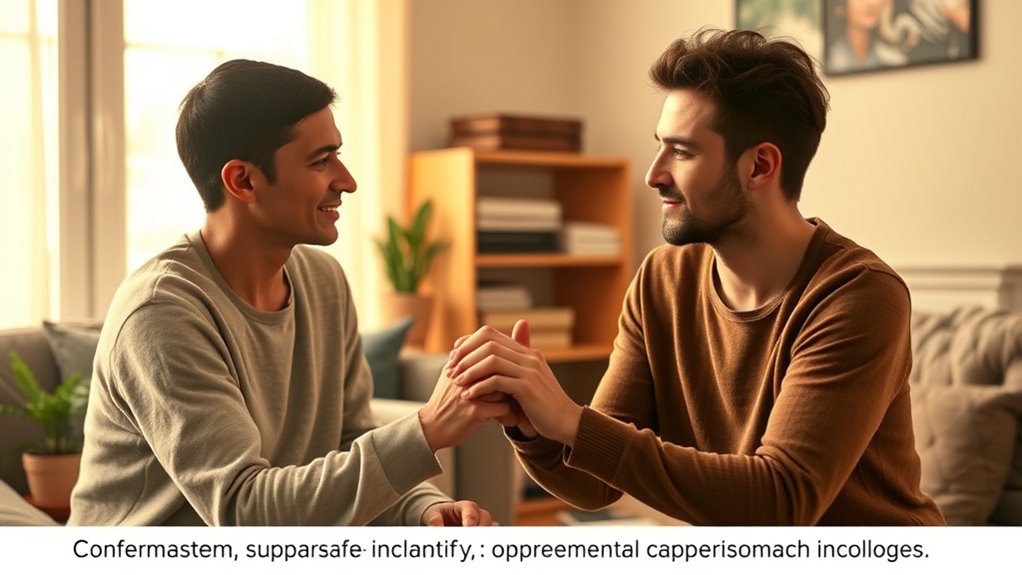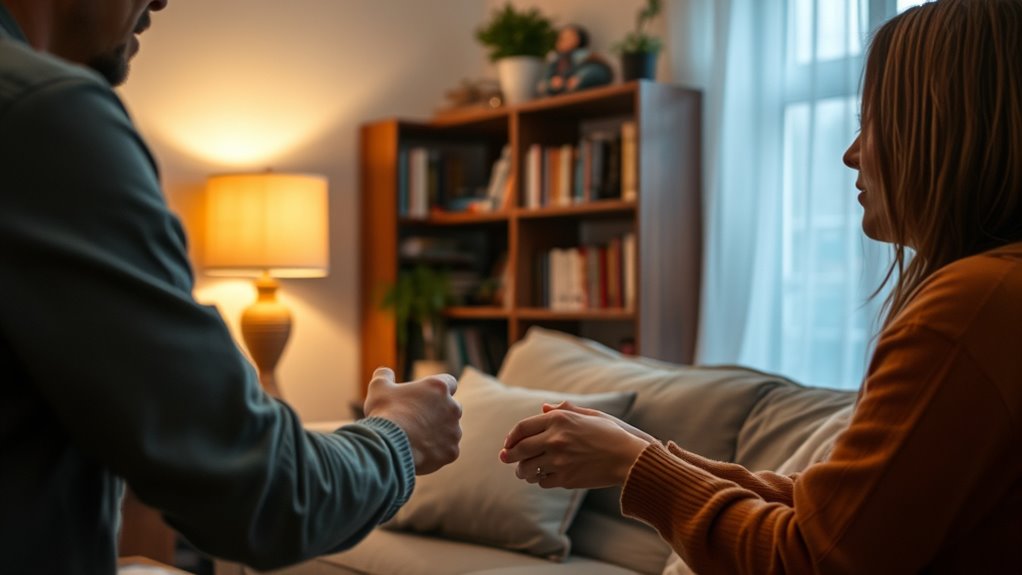Supporting a partner with BPD without losing yourself requires setting clear boundaries, practicing honest and compassionate communication, and prioritizing your own wellbeing. Recognize their emotional triggers and respond calmly, while maintaining your personal interests and support network. Stay consistent and respectful, and don’t forget to care for your mental health through self-care and stress management. If you adopt these strategies, you’ll find it easier to maintain balance and build a healthier relationship over time.
Key Takeaways
- Prioritize your own emotional wellbeing through self-care, boundaries, and support networks to prevent caregiver burnout.
- Practice compassionate, calm communication and set clear boundaries to foster safety without sacrificing your needs.
- Educate yourself about BPD to develop understanding, patience, and realistic expectations for the relationship.
- Maintain personal interests and social connections to preserve your identity and emotional resilience.
- Recognize early signs of burnout and seek professional support or therapy to sustain both your wellbeing and relationship health.
Recognizing the Emotional Landscape of BPD

Have you ever wondered what’s really happening inside someone with BPD? Their emotional landscape is intense and unpredictable. You’ll notice heightened responses to negative feelings like fear, anger, or rejection, often reacting more strongly than expected. Emotions shift rapidly, sometimes triggered by minor events or social cues, making their moods feel unstable. Once upset, they may stay overwhelmed longer than usual, struggling to return to calm. Negative perceptions dominate, leading them to interpret situations pessimistically. Often, they unconsciously suppress emotions to avoid feeling overwhelmed, but this can backfire, causing emotional overload. Recognizing these patterns helps you understand that their reactions aren’t intentional but part of a complex emotional dysregulation. Emotional volatility is a core characteristic of BPD, which can make interactions challenging but also offers opportunities for understanding through patience and compassion in your relationship. Developing awareness of their emotional responses can facilitate more empathetic support and reduce misunderstandings. Furthermore, understanding the role of validation techniques can help in creating a supportive environment that fosters emotional stability. Additionally, understanding the importance of emotion regulation strategies can aid in navigating these intense reactions more effectively. Recognizing dysregulation patterns can help you respond more thoughtfully and avoid escalation, especially when combined with an understanding of mindfulness practices, which can help both partners manage emotional reactions better.
Managing Your Own Emotional Wellbeing

Managing your own emotional wellbeing is essential when supporting a partner with BPD, as their intense and unpredictable emotions can profoundly impact your mental health. To stay balanced, focus on effective emotional regulation strategies that help you cope with heightened stress and reactivity. Remember, you don’t have to assume the role of therapist; seek support through peer groups or individual therapy to process your feelings. Prioritize self-care by engaging in activities that restore your energy and reinforce your identity outside the relationship. Building a strong support network and pursuing personal interests help maintain your autonomy. Developing emotional awareness allows you to recognize your feelings early and respond calmly. Practicing self-compassion is also crucial, as it helps you maintain resilience and avoid burnout in challenging situations. Incorporating emotional regulation techniques can further enhance your ability to manage stress effectively. Additionally, understanding the importance of creative practice can provide healthy outlets for emotional expression and stress relief. Engaging in regular self-reflection can help you stay attuned to your needs and boundaries, preventing emotional exhaustion. Practicing mindfulness and setting boundaries can significantly improve your emotional resilience and overall wellbeing. Recognizing the value of self-care routines can support ongoing mental health maintenance amidst challenging circumstances.
Establishing and Maintaining Healthy Boundaries

Setting clear limits helps create a sense of safety and predictability in your relationship. Communicate your boundaries consistently and calmly to avoid confusion or mixed signals. Respecting each other’s personal space fosters trust and reduces emotional tension. Recognizing BPD symptoms can guide you in understanding when boundaries are necessary to protect your well-being. Implementing healthy boundary-setting strategies supports both partners’ emotional health and relationship stability. Additionally, understanding the importance of space management can help prevent feelings of being overwhelmed or smothered, promoting healthier interactions. Practicing somatic awareness can also help you stay attuned to your body’s signals and recognize when your boundaries are being challenged, allowing for more effective responses. Being attentive to relationship warning signs can help you identify when boundaries need reinforcement to maintain healthy dynamics. Incorporating Glycolic Acid benefits into skincare routines may improve skin texture and confidence, which can positively influence your overall well-being.
Set Clear Limits
Establishing clear boundaries is essential for creating a stable and healthy relationship with a partner who has BPD. Boundaries help both of you manage emotions and promote understanding. To set effective limits:
- Clearly define acceptable and unacceptable behaviors, like walking away from verbal abuse.
- Communicate boundaries assertively and consistently to prevent misunderstandings.
- Use empathetic language to reduce defensiveness and foster connection.
- Reinforce boundaries calmly, even during emotional reactions, to maintain stability.
- Recognize the importance of cultural intelligence in understanding and respecting each other’s backgrounds, which can enhance boundary-setting and communication strategies.
- Incorporate vetted approaches to boundary-setting that are proven effective in supporting mental health and relationship stability.
Communicate Consistently
Consistent communication is essential for maintaining healthy boundaries with a partner who has BPD, as it creates a sense of predictability and safety. By establishing regular check-ins, you help your partner feel secure and understood, reducing emotional volatility. Focus on clear, empathetic exchanges that distinguish between sharing feelings and solving problems—avoid jumping straight to solutions unless asked. Use validation and active listening to acknowledge their emotions without judgment, fostering trust and calm. Be mindful of double bind patterns that may trigger fears of abandonment; recognize these behaviors as driven by emotional needs, not manipulation. Understanding emotional regulation is crucial for navigating these dynamics effectively. Consistency in your responses and language reinforces stability. Regular, honest communication helps prevent misunderstandings, supports emotional regulation, and nurtures a balanced, respectful connection. This approach also promotes a sense of reliability, which is crucial for building trust with a partner experiencing intense emotional swings. Incorporating emotional regulation strategies into your communication can further enhance the stability of your relationship and help manage unpredictable reactions. Additionally, being aware of the importance of special occasions in maintaining emotional connection can provide opportunities for positive interactions and reassurance. Maintaining such consistency can also mitigate the impact of potential emotional volatility, fostering a healthier relationship environment.
Respect Personal Space
How can you guarantee that personal boundaries are respected in a relationship with someone who has BPD? First, establish clear boundaries through open conversations. Second, remain consistent in enforcing these boundaries to build trust. Third, respect your partner’s need for personal space, recognizing that they may prefer larger distances due to social anxiety. Fourth, educate both yourself and your partner about the importance of boundaries, which helps reduce misunderstandings. To support healthy boundaries: Boundary violations are often a persistent issue 1. Clearly communicate your needs and listen to theirs 2. Maintain consistency in your actions and reactions 3. Be adaptable but firm when boundaries are tested 4. Seek therapy to develop effective boundary management skills. Recognizing that water-based therapies like hydrotherapy can also promote relaxation and emotional regulation can be beneficial in managing stress related to boundary setting. Incorporating protective styling benefits such as using crochet styles for locs can serve as a metaphor for establishing boundaries that protect your emotional well-being. Additionally, understanding the effectiveness of eye patches in reducing puffiness and promoting relaxation can serve as a reminder of the importance of self-care when navigating boundary challenges. An understanding of the psychology of boundaries can help you develop more effective strategies for maintaining them. Respecting personal space fosters security and minimizes conflicts, strengthening your relationship.
Communicating Effectively During Turbulent Moments

When emotions run high, staying calm and present helps de-escalate the situation. Using clear, gentle language shows your partner you’re there to listen without adding pressure. This approach can create a safer space for honest communication during turbulent moments. Recognizing and avoiding double bind situations—where conflicting messages can increase confusion—can also help maintain trust and stability during difficult exchanges. Being aware of communication style differences can further improve understanding and reduce misunderstandings during sensitive discussions. Incorporating mindfulness techniques, such as deep breathing or focused attention, can support both you and your partner in staying grounded during emotional episodes.
Stay Calm and Present
During turbulent moments, staying calm and present is essential for effective communication with your partner who has BPD. When emotions run high, your steady presence can help de-escalate the situation and foster understanding. Focus on maintaining your composure and listening attentively. This helps your partner feel heard and validated, reducing their emotional intensity. To deepen your approach:
- Practice deep breathing to center yourself before responding.
- Maintain eye contact and an open posture to show engagement.
- Use gentle, reassuring language to create a safe space.
- Remind yourself to stay grounded in the moment, avoiding reactive impulses.
Use Clear, Gentle Language
Using clear, gentle language is essential when maneuvering turbulent moments with your partner who has BPD. It helps de-escalate tension and creates a sense of safety. Be direct and specific about your feelings without blaming or criticizing. Use a calm tone to avoid triggering defensiveness. Validating their feelings and practicing active listening can foster trust and understanding.
| Be Clear | Use Gentle Language | Validate Feelings |
|---|---|---|
| Say exactly what you mean | Speak softly and kindly | Acknowledge their emotions |
| Avoid ambiguous words | Use a soothing tone | Show empathy and understanding |
| Keep your message simple | Refrain from harsh language | Reassure them they’re heard |
Supporting Your Partner’s Treatment Journey

Supporting your partner’s treatment journey for BPD involves more than encouraging therapy; it requires active participation and understanding. You can help by learning about BPD symptoms, treatment options like DBT, and what to expect from therapy. This knowledge fosters empathy and patience, making it easier to support effectively. Diagnosis of Borderline Personality Disorder Usually, diagnosis is made through a detailed assessment by a mental health professional, which can help you understand the specific challenges your partner faces. Consider these key steps:
- Encourage consistent attendance at therapy sessions and be involved when appropriate.
- Learn about different treatment approaches so you can set realistic expectations.
- Participate in family or partner therapy if offered, to strengthen understanding.
- Support your partner in adhering to their treatment plan, including medication or coping strategies.
Your active support can make a significant difference in their progress.
Avoiding Enabling and Over-Responsibility

When caring for a partner with BPD, it’s essential to recognize the fine line between helpful support and enabling harmful behaviors. Enabling happens when your actions unintentionally reinforce unhealthy patterns, like taking on too much responsibility or failing to set boundaries. To avoid this, focus on fostering independence and encouraging accountability. Use the table below to guide your approach:
| Action | Do | Don’t |
|---|---|---|
| Set boundaries | Be firm but respectful | Be passive or avoid limits |
| Promote responsibility | Encourage decision-making | Take over tasks unnecessarily |
| Support professional help | Suggest and facilitate | Force or pressure for therapy |
Balance support with self-care, and remember to prioritize your well-being, avoiding burnout or losing your sense of self.
Navigating Conflict With Compassion and Clarity

When conflicts arise, it’s important to recognize your partner’s emotional triggers and respond with calm communication. Setting clear boundaries around disagreements helps prevent escalation and keeps conversations respectful. By approaching conflicts with compassion and clarity, you create a safer space for both of you to work through challenges together.
Recognize Emotional Triggers
Recognizing emotional triggers in a partner with BPD is essential for maneuvering conflicts with compassion and clarity. When you identify what sparks their distress, you can respond thoughtfully instead of reactively. Common triggers include:
- Fear of abandonment — feeling insecure about being left can lead to emotional outbursts.
- Criticism or rejection — even well-intentioned feedback may trigger feelings of inadequacy.
- Traumatic memories — resurfacing childhood trauma can cause intense reactions.
- Stressful life events — changes like job loss or moving heighten emotional vulnerability.
Practice Calm Communication
Practicing calm communication is essential for steering conflicts with a partner who has BPD. When emotions run high, validate their feelings with empathy, acknowledging their experience without judgment. This helps them feel heard and reduces emotional escalation. Keep your tone gentle and even, using slow, deliberate speech to promote understanding and calmness. Grounding techniques, like deep breathing, can help you stay composed. Use clear, straightforward language to avoid misunderstandings, focusing on behaviors rather than character. Frame your statements with “I” messages to minimize blame. Practice active listening, giving your full attention and reflecting back what you hear to show you understand. finally, approach disagreements with a collaborative mindset, emphasizing shared solutions and mutual respect to foster trust and emotional safety.
Establish Conflict Boundaries
Establishing clear conflict boundaries is essential for maintaining a respectful and safe relationship with a partner who has BPD. Boundaries protect both your emotional well-being and theirs, helping prevent escalation and burnout. To do this effectively, consider these key steps:
- Clearly define what behaviors are acceptable during disagreements and communicate these limits calmly.
- Be consistent in enforcing boundaries so your partner understands they are serious and non-negotiable.
- Use boundaries to create space for de-escalation, allowing both of you to pause and regain composure.
- Model respect by honoring your limits and encouraging your partner to do the same, fostering trust and emotional safety.
These boundaries guide conflict resolution with compassion and clarity, supporting healthier interactions.
Maintaining Your Personal Identity and Interests

How can you stay true to yourself while supporting a partner with BPD? The key is to prioritize your personal interests and activities. Schedule regular hobbies or solo pursuits that reinforce your self-identity outside the relationship. These activities help you recharge emotionally and reduce stress, keeping you resilient. It’s also essential to set healthy boundaries—clarify limits on emotional support and protect your time. This prevents codependency and encourages respectful communication. Cultivate self-awareness through reflection, journaling, or mindfulness, so you understand your needs and avoid over-identifying with your partner’s emotions. Maintaining friendships and social networks offers external support and perspective, reducing feelings of isolation. Lastly, invest in your professional growth and personal goals to foster confidence and a sense of fulfillment beyond your role as a partner.
Recognizing Signs of Emotional Burnout

Supporting a partner with BPD can be emotionally taxing, and recognizing when you’re nearing burnout is essential to maintaining your well-being. Burnout manifests in physical, emotional, cognitive, and behavioral signs.
- You may feel constantly exhausted, with headaches or sleep issues.
- Emotional signs include feeling drained, cynical, or hopeless.
- Cognitive struggles like difficulty concentrating or making decisions become more frequent.
- Behavioral changes such as withdrawal, decreased motivation, or increased absenteeism signal burnout.
Being aware of these signs helps you intervene early, preventing further harm. burnout isn’t just about feeling tired—it affects your health, mindset, and relationships. Recognizing these indicators allows you to set boundaries and seek support before burnout worsens.
Building a Support Network for Both of You

Building a strong support network is essential for both partners steering BPD. You need diverse, reliable sources to help navigate the challenges and reduce feelings of isolation. Support groups specifically for SOs can provide valuable connection and understanding, but access remains limited. Healthcare professionals often overlook SO needs, so advocating for inclusion in care discussions can build trust and improve support. Connecting with well-connected individuals in your social network strengthens your support system and fosters trust. Address stigma and shame by promoting open dialogue and education about BPD. Expanding peer and professional resources can reduce negative interactions and increase emotional safety. A structured, well-integrated support network not only benefits your partner but also helps you maintain your well-being while managing the complexities of BPD.
Frequently Asked Questions
How Can I Tell if I’M Enabling My Partner’S BPD Behaviors?
You might be enabling your partner’s BPD behaviors if you’re constantly giving reassurance, excusing destructive actions, or taking responsibility for their emotions. If you avoid setting boundaries, cover up consequences, or rescue them from crises, you’re reinforcing their dependence. Recognize if you’re accepting manipulation, tolerating verbal abuse, or suppressing your needs to keep the peace. These patterns prevent healthy growth and keep you trapped in an unhealthy dynamic.
What Are Practical Ways to Protect My Mental Health Daily?
The mental health impact can feel like an unending storm, but you can find calm. To protect your daily mental health, set clear boundaries and communicate them calmly. Practice self-care activities, like exercise or hobbies, to recharge. Use stress management techniques, like deep breathing or meditation, regularly. Stay connected with your support network, and don’t hesitate to seek professional help. Prioritize your well-being to stay resilient amidst the chaos.
How Do I Handle Intense Emotional Outbursts Without Escalation?
When facing intense emotional outbursts, stay calm and breathe deeply to avoid escalation. Use empathetic listening and validate their feelings without judgment, which helps soothe the situation. Set clear boundaries to protect your emotional well-being, and communicate consistently to foster understanding. Remember, maintaining your own mental health is essential—seek support, practice self-care, and consider professional help if needed, ensuring you can support effectively without losing yourself.
When Should I Consider Couples Therapy for BPD Support?
When should you consider couples therapy for BPD support? If you notice ongoing communication breakdowns, frequent conflicts, or emotional exhaustion, it’s time to seek help. Couples therapy offers structure and external support, helping both of you manage BPD symptoms and improve your relationship. If traditional coping strategies aren’t enough and emotional boundaries are blurred, therapy can foster understanding, reduce conflicts, and rebuild connection, making it a valuable step forward.
How Can I Rebuild Trust After a Betrayal or Lie?
Picture trust as a fragile glass that’s shattered by betrayal. To rebuild it, give your partner space to heal and avoid rehashing past hurts. Show patience and support, like carefully placing each piece back together. Use therapeutic tools like DBT and CBT to strengthen emotional resilience. Remember, your consistent kindness and boundaries help mend the cracks, fostering a renewed sense of safety and trust over time.
Conclusion
Remember, you can’t pour from an empty cup. Supporting your partner with BPD takes patience, compassion, and self-care. By setting boundaries, staying connected to your own interests, and seeking support, you protect your well-being while helping your partner thrive. Keep in mind that “you can’t control the storm, but you can learn to dance in the rain.” Stay resilient and gentle with yourself—you’re doing an important, challenging, and loving job.
Theresa is the visionary force behind Borderline Syndrom, steering our content towards excellence and integrity. With a keen eye for detail and a deep understanding of BPD, she ensures that our articles, stories, and resources offer our readers valuable insights, hope, and guidance. Theresa’s leadership not only shapes our editorial direction but also fosters a space where voices on BPD are heard and respected.










